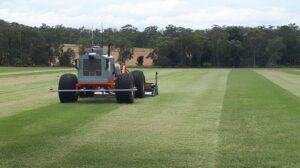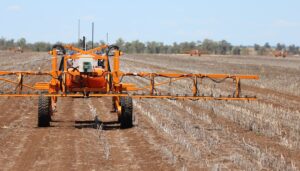
Cutting costs with robotics and AI
By John Fitzsimmons
Horticultural enterprises today have access to an increasingly broader and evolved range of equipment and technologies, which are still revealing themselves step by step. Much of the transformation in this space is occurring on-farm, with robots and artificial intelligence increasingly used to drive productivity.
The big driver of technology adoption is ultimately cost savings – in the form of less labour, less costly inputs like chemicals and fertilisers, greater flexibility in field operations, and timeliness of operations. Environmental benefits are also up there. Of course, the quantum of savings must be commensurate with the cost of investment in new technologies, thus enterprises operating at scale will be, and have been, the early adopters.
The first advances will also therefore be in the most widely needed categories. For horticulture that often means application of pest and disease control measures, irrigation, and weed control. New control and implementation technologies for logistics, both behind and beyond the farm gate, are also often readily justified. These are also areas of operation that can more readily be measured and options compared. Depending on the crop or plants, harvesting is often a greater challenge, both in terms of recognition, selection and control systems, and in mechanical solutions.
Enterprise managers also need to consider the larger business picture, as always. For example, grape growers are battling rising costs and labour shortages as well as declining sales volumes in a changing consumer market. So, the appeal of emerging ‘disease-fighting robots’ is piquing greater interest. It is hoped technological breakthroughs will provide both economic and environmental advantages.
One company, Agri Automation, is collaborating with Wine Australia to trial a device using ultraviolet (UV) radiation rather than chemicals, to treat vineyard diseases. An autonomous vehicle travels down the rows exposing the vines to UV-C. This approach is reportedly most effective when applied at night.
It works by destroying the DNA of diseased cells so they cannot rebuild themselves, effectively controlling the disease. This method can replace traditionally applied fungicides, pesticides and herbicides with the attendant costs of materials, labour and time. The flexibility to treat the vines day or night and in all weathers can improve timeliness and enhance outcomes. Similar technology is being trialled in New Zealand and the United Kingdom.
A complementary advance is the use of artificial intelligence (AI) to identify whether plants are diseased and need to be treated. Australian company BioScout has created a device that scans the air in a vineyard for pathogens every 12 hours. From data collected, AI is used to identify whether diseases are present in the crop. It indicates the level of spores present and the severity of infection, helping the grower to decide when to apply treatments. Such advances will help reduce the practice of blanket spraying (e.g., for powdery and downy mildew) and thus help to reduce the use of chemicals over time, an environmental gain.

‘Auto-fill’ programs and technologies are now also a reality, allowing robots to work around-the-clock, refuelling and topping up with chemicals or water autonomously as required. Queensland company SwarmFarm’s auto-fill system is already a real-world option for their robots that can weed, mow and spray crops. The technology allows their robots to find refilling stations, dock, reload, and return to work, all without human intervention. It is an Australian first and local farmers are the first in the world to have access to it.
SwarmFarm’s thinking has also upended conventional approaches. Rather than continuing with ever-bigger mechanical equipment, SwarmFarm’s founders came up with the idea of large numbers of smaller autonomous machines ‘swarming’ across the enterprise completing many and diverse tasks simultaneously. These robots are equipped with GPS, advanced software, and engines capable of running for up to 24 hours on a single tank of fuel. With add-ons like smart camera systems, they can apply chemicals only where needed. The benefits include less soil compaction, fewer chemicals, shorter workdays and now, with the autofill feature, round-the-clock operation. There are now about 150 SwarmFarm robots operating in Australia, either bought outright or leased on 3-year plans. The company also recently opened a manufacturing hub in Toowoomba. A recent survey found nearly 30% of Australian grain growers are now using autonomous or semi-autonomous equipment.
Autonomous robots are not just about spraying or irrigation. They are increasingly being developed to revive one of growing’s oldest and most tedious (for humans) tasks, mechanical weeding. Robots like FarmDroid and Stout imported from Denmark and the United States are reviving these weed-control methods to slash chemical use. Guided by GPS and cameras, the machines use knives and wires to take out pest plants by ‘hand’ instead of spraying.
The Danish machine is solar-powered, and weeds or seeds using GPS. Powered by two batteries that are charged by four solar panels, FarmDroid claims the bot can run 24 hours a day in sunny conditions and can cover about 900 metres an hour, or 6 hectares a day. The Stout weeding machine is attached to a tractor, weeding using cameras and AI. One major advance claimed for the Stout technology is that it can differentiate between the weeds and the crop based on species, not relying on colour!
One of the challenges in Australia is connectivity, especially after the shutdown of the 3G mobile network. There are many areas where 4G or 5G coverage is still simply not available or reliable. There is also a parallel need for farmers and growers to be trained and become competent with implementing and operating the new technologies. Fortunately, many of the suppliers of innovation have attracted a new and diverse workforce – younger, techy, flexible, innovative and skilled in areas many in horticulture have probably not heard of (*see also Hort Journal Australia’s past articles on education, skills, training and careers). The arrival of a new generation of agricultural and horticultural technicians in our plant industries and regions is overdue.
The autonomous robots are now becoming mainstream. And as one user commented, ‘It is more a matter that reliability of machines far outweighs the reliability of people.’
But concerns do remain about the affordability of the technology. It remains the biggest barrier to adoption.
